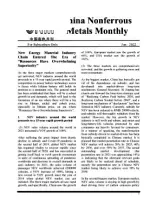Hunan Rare Earth Group Approved
2012-08-15
Following Guangdong, Guangxi, Fujian and Jiangxi, Hunan announced that it would consolidate its rare earth resources - the consolidation plan of Hunan Rare Earth Group has been approved. Consolidation of the rare earth industry of south China is in full swing.
According to “Several Opinions of the State Council on Promoting the Sustainable and Healthy Development of Rare Earth Industry”(hereinafter referred to as “Several Opinions”)released in 2011, the expression of “make the industrial concentration of the top 3 enterprises of the ion-type rare earth industry in south China exceed 80% in one year or two years” made a splash in the rare earth industry of southern China.
After the “Several Opinions” was released, in order to maintain their advantages in rare earth resources, all provinces in south China sped up to organize their own rare earth consolidation platforms so as to “hold fast to” and “upgrade”the rare earth industry, so as to cope with busi-ness expansion of state-owned enterprises directly under the central government.
Among them, Guangdong province, through a series of assets operation, made Rising Nonferrous Metals become a level-1 holding subsidiary of Guangdong Rising Assets Management Co., Ltd.. Subsequently, it established Guangdong Rare Earth Industrial Group, and brought forward a consolidation timetable, so as to strengthen control on rare earth mines in the province.
Fujian is unwilling to lag behind. It put forward“Fujian model”, i.e., follow the industrial direction of “vigorously developing deep processing through orderly development of resources led by Xiamen Tungsten”.
Lin Donglu, Secretary-general of the Chinese Society of Rare Earths, indicated that, although most provinces in south China have organized their respective rare earth groups, they are not powerful enough in terms of terminal application of rare earth and none of them can stand out in the crowd. While Minmetals, a stateowned enterprises directly under the central government, performs better in terms of application though it does not control resources.“The central government has ever put forward the concept of consolidation of the top 3 rare earth enterprises in south China, which was proposed at the earliest to be spearheaded by state-owned enterprises directly under the central government, and later consolidated by all local competent enterprises., However, as seen from the current situation, the situation of rare earth consolidation in south China remain unclear as before.”
China’s ion-type rare earth mines are mainly located sparsely at 7 southern provinces. Rare earth enterprises are vying each other for resources and the outlook of rare earth consolidation remains uncertain. But the situation of rare earth consolidation remains relatively clear in north China.
At present, light rare earth resources in north China have been basically consolidated by REHT, which has controlled raw rare earth ores through its REHT International Trade Company. Now, REHT International Trade Company has basically controlled the unified pricing power of rare earth resources in Baotou.REHT has completely monopolized rare earth resources in north China in a top-down manner and the big picture of light rare earth resources in north China has taken shape.
“Light rare earth resources of north China are mainly located in Inner Mongolia, Sichuan and Shandong, but REHT has basically controlled such resources in north China.” Lin Donglu considered that in the future, the situation that REHT consolidates rare earth resources in Inner Mongolia as well as Sichuan and Shandong has taken shape.
杂志排行
China Nonferrous Metals Monthly的其它文章
- Amer International Group to Complete a 500,000-Ton Refined Copper Project in 2015
- Laizhou to Build the World’s Largest Gold Industrial Base
- Guangdong to Build Rare Earth Deep Processing Industry Chain
- Wenshan’s 800,000-ton Alumina Project Completed
- Henan’s 80% Aluminum Enterprises Remains in the Red
- Favorable Policies for Copper Imported processing trade Formulated
